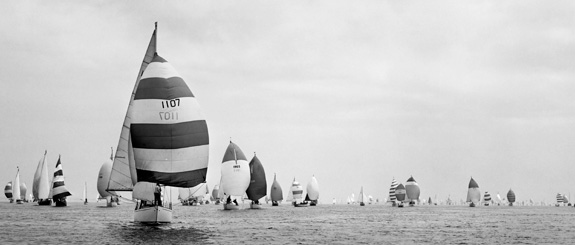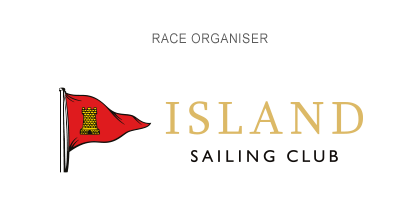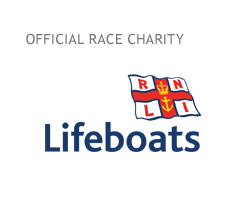The RaceHistory

The little sloop Meon Maid II runs down the western Solent under Spinnaker in 1964 (photo: Beken)
1930s - 1940s
The original idea for the Island Sailing Club's (ISC) Round the Island Race came from member Major Cyril Windeler. In 1930 he suggested a handicap race around the Isle of Wight which could cater for smaller boats - those in the category 5 to 25 tons. He may, at that time, have been enjoying a quiet joke at the expense of the Royal Yacht Squadron, who had stated that their members must own a yacht of minimum 30 tons!
The first race took place in 1931 with 25 entries and it was indeed one of the smaller boats which won. The successful skipper, Peter Brett, competed in a 22 foot Cornish fishing boat "Merry Conceit". He had bought it, in partnership with his friend Henry Trefusis, from the builders in Looe, for the sum of £45. The top trophy then, as now, was the Gold Roman Bowl. The original had been seen on display in a goldsmiths near the site of a Roman wharf in London. It had been dredged up from the River Thames. Major Windeler so loved the design he ordered a replica to be made by Bruce Benzie, the Cowes jewellers. Drama followed in 1933 when the leading yacht, Isaac Bell's "Rosemary IV", lost her mainsail just before the finish line. By setting a trysail, she just managed to beat her rival, "Felise", by 46 seconds. Meanwhile, Dr R T Cooke's 32 year old cutter "Enid" sprang a leak and, in spite of frantic pumping, sank off Alum Bay.

The Schooner Seabill ghosts over the start line in 1959 (photo: Beken)
After one of the early races, a competitor suggested to winner Chris Ratsey, of the Cowes sailmakers and then Rear Commodore of the ISC, that "Evenlode" might have fouled his yacht. So, acting like a true gentleman, Ratsey of course declined the trophy. Major Windeler was so impressed with this example of Corinthian spirit that he bought a Silver Roman Bowl and presented it to Chris Ratsey as a special prize. It is still awarded, but now for the second placed yacht overall in IRC. Chris Ratsey went on to win the Gold Roman Bowl, fair and square, in 1938.
It was not until the outbreak of World War II in 1939 that Major Windeler finally won his trophy, sailing a 7 ton auxiliary cutter "Kalliste" designed by Jack Giles. The triumph was quickly followed by a ban on private, leisure sailing for the duration of the war but the Round the Island Race resumed in the peacetime of 1946 under Major Sir Philip Hunloke as Commodore.
1950s-1980s and record breakers
From that time, entry numbers steadily increased, from 105 in 1950, to 1,309 in the mid 1980s. A superb turnout of 1,813 was seen in 1989, the Centenary of the Island Sailing Club but even that was exceeded in 2008 with a record 1,875 entries. Until the mid 1970s, the event demanded maximum dedication from the race officers, as there was no time limit. Senior Island Sailing Club members have vivid memories of keeping a lonely vigil in a launch until long after dark, awaiting the stragglers. Three green lights on a pole, powered by a car battery, marked the line. The ISC race management team, afloat and ashore, now numbers over 160.

Morning Cloud IV on her way to winning the Gold Roman Bowl for the 4th time in 1980 (photo: Beken)
Even during his term as Prime Minister, The Rt. Honourable Sir Edward Heath KG, MBE, MP was a keen supporter of sailing. He won the Round the Island Race four times; three of them in consecutive years in the early 1970s on "Morning Cloud II" and "Morning Cloud III". In 1980 he took the top trophy once more in "Morning Cloud IV". The Gold Roman Bowl has only been won twice by women - Mrs Tobin on "Barbar" in 1954 and Julia Dane on "Glass Onion" in 1982.
Record breaking has become an important feature of the race, especially since a multihull class was introduced in 1961. The course record in 1962 was set by Don Robertson at 5 hours 50 minutes. On the 50th anniversary of the race in 1986, things had speeded up and "Paragon", sailed by Mike Whipp and Olympic medallist Rodney Pattison, flew round in 3 hours 55 minutes and 28 seconds, creating a new record. This stood until 2001 when Francis Joyon and 'Idec' recorded a time of of 3 hours 8 minutes and 29 seconds - a record that was not beaten until 2013, when Sir Ben Ainslie helmed his AC45 catamaran to post the first sub-three-hour race with a time of 2 hours 52 minutes and 15 seconds. Three years later, Lloyd Thornburg's Phaedo^3 took an astonishing 30 minutes off this record, a time that was beaten in 2017 by 60 seconds when Ned Collier Wakefield finished the race in just 2 hours 22 minutes and 23 seconds on Concise 10.
Property developer and current record holder, Mike Slade has broken the monohull record on five occasions, firstly in 1991 sailing "Ocean Leopard". He then did 23 minutes better in 1996 sailing "Hoya Longabarda" and further improved in 2001 with "Skandia Life Leopard" at 4 hours 5 minutes and 40 seconds. The lively conditions in 2008 enabled him to break his own record once more in "ICAP Leopard", and the near-perfect conditions of 2013 allowed ICAP Leopard to shave a further 10 minutes off her own record, posting an elapsed time of 3 hours 43 minutes and 50 seconds.
Race management procedures have also become faster. In the early 1970s the General Electric Information Service Company began to organise race results, which meant the onerous task of calculating times and rating factors did not have to be carried out manually. A week before the race, the GEISCO equipment would arrive to be installed in the Club's reading room. It would take engineers a full day to set up the system and connect it to lines specially provided by the GPO. Results would not be calculated until the final deadline of 9.30pm, with the lucky winners called out by the Club Secretary the following morning.

A mixture of yachts skirt by the Needles in 1999 (photo:Cristel Clear)
21st Century information technology
Today, the results are processed by Next Generation Results who can ensure that hand-written finishing records reach the results room, still known as "The Bunker" despite Cowes Combined Clubs' excellent new facilities, within a matter of minutes. Competitors and spectators alike can see fast on-screen results flashed up on Event TV sites in Cowes or pick them up from around the world via the dedicated website. 2008 saw a march forward in technology when declarations could be made by mobile phone text messaging, sending the floating "dec barge" system into retirement.
This was followed by the introduction of GPS tracking in 2010 and the launch of the race's own dedicated broadcast TV channel, RTI-TV in 2015, allowing friends, family and sailing fans around the world to follow the race online. During this period, social media also became a popular communication platform amongst the younger generation, providing a quick and easy way to increase communication throughout the large Round the Island Race community.
In recent years the Round the Island Race has become a popular challenge for sailors at all levels of experience and abilities, attracting classic yachts such as the elegant J Class "Velsheda" as well as state-of-the-art, record-breaking greyhounds. Olympic gold medallists have tried their luck in the Sportsboat Rule and IRC classes, whilst grand old ladies of the sea, "Suhaili", "Gipsy Moth IV" and "Lively Lady", have given more modern designs a run for their money. The ISC Rating System division, for un-rated yachts, now exceeds the regular racers. For some of these sailors, this is their one race of the year and many use the event as a first taste of yacht racing. Entries come from all over the south and east coasts of England as well as from France, Belgium, Channel Islands and further afield. The event is reported in media across the world – from Brazil to Japan, Hungary to New Zealand.
The race often runs true to Cyril Windeler's original aspirations, with small boats, perhaps finishing well into the evening, carrying off the top prizes. This was true in 2005 when the 1978-built quarter-tonner "Purple Haze" came up trumps for skipper Tony Dodd. A year later Jeremy Rogers' Contessa 26 "Rosina of Beaulieu" became the only boat in the history of the race to win the Gold Roman Bowl three times.
Special competitors who completed the course in challenging conditions include 81 year old Wendy Ballantine, who sailed in the 25th, 50th and 75th editions of the event, and 90 year-old Ray Moxley, who raced his newly built 40' revolutionary catamaran in 2013. Owen Parker, Bob Fisher, Shirley Robertson, Ken Beken and many other devotees of the race included their memories in a special 75th anniversary publication, and in 2011 the race celebrated its 80th Anniverary with a special exhibition supported by the then title sponsor J.P. Morgan Asset Management. Click here for a copy of the 80th Anniversary Exhibition Brochure.
Charity fundraising has always been a fun and exciting part of the Race. Many charitable causes benefit, including the official Race charity, The Ellen MacArthur Cancer Trust raised £267k from their recent involvement, a sum that has enabled an additional 472 young people to join the Trust for a four day trip and 119 young people in recovery from Cancer to be able to sail in the Race. In total, the amount raised for good causes since 2010 has reached a fabulous sum of £500,000.
The 2020 Race and COVID-19
The global COVID-19 pandemic resulted in the Race being cancelled for the first time since World War II. It had been originally rescheduled from its late May date to the end of September, which would have been the first time the Race had been run at the end of the summer. However, the logistical issues surrounding the safe running of such a large event with the virus still present and circulating in the UK proved insurmountable, and it was with great regret that the 2020 edition of the iconic event was called off.
2021 - celebrating 90 years of Round the Island
The Round the Island Race celebrated its 90th anniversary in 2021. A retrospective on the Race, written by former Yachts & Yachting writers Malcolm McKeag and Barry Pickthall, was published in the June 2021 edition of Sailing Today.
Gold Roman Bowl winners
A complete list of winners of the Race's main trophy, the Gold Roman Bowl, is available here.








